Occupational Safety and Health Risks in Confined Spaces Report
VerifiedAdded on 2023/06/10
|27
|8375
|479
Report
AI Summary
This report focuses on the occupational health risks affecting workers in confined spaces and the importance of occupational safety in reducing these risks. It discusses various hazards, including atmospheric and non-atmospheric hazards, and the potential health consequences for employees. The report emphasizes the role of effective safety management training programs, responsible management, and proper supervision in mitigating workplace hazards. It reviews relevant literature and provides accident statistics from the Ministry of Manpower (MOM) and International Labour Organization (ILO) to illustrate the severity of the issue. The study also identifies gaps in safety measures, such as lack of proper personal protective equipment and inadequate ventilation, highlighting the need for improved safety protocols and training to protect workers in confined spaces like manholes. The report concludes by stressing the importance of a positive work culture, sufficient funding, and registered companies to ensure effective implementation of safety measures.
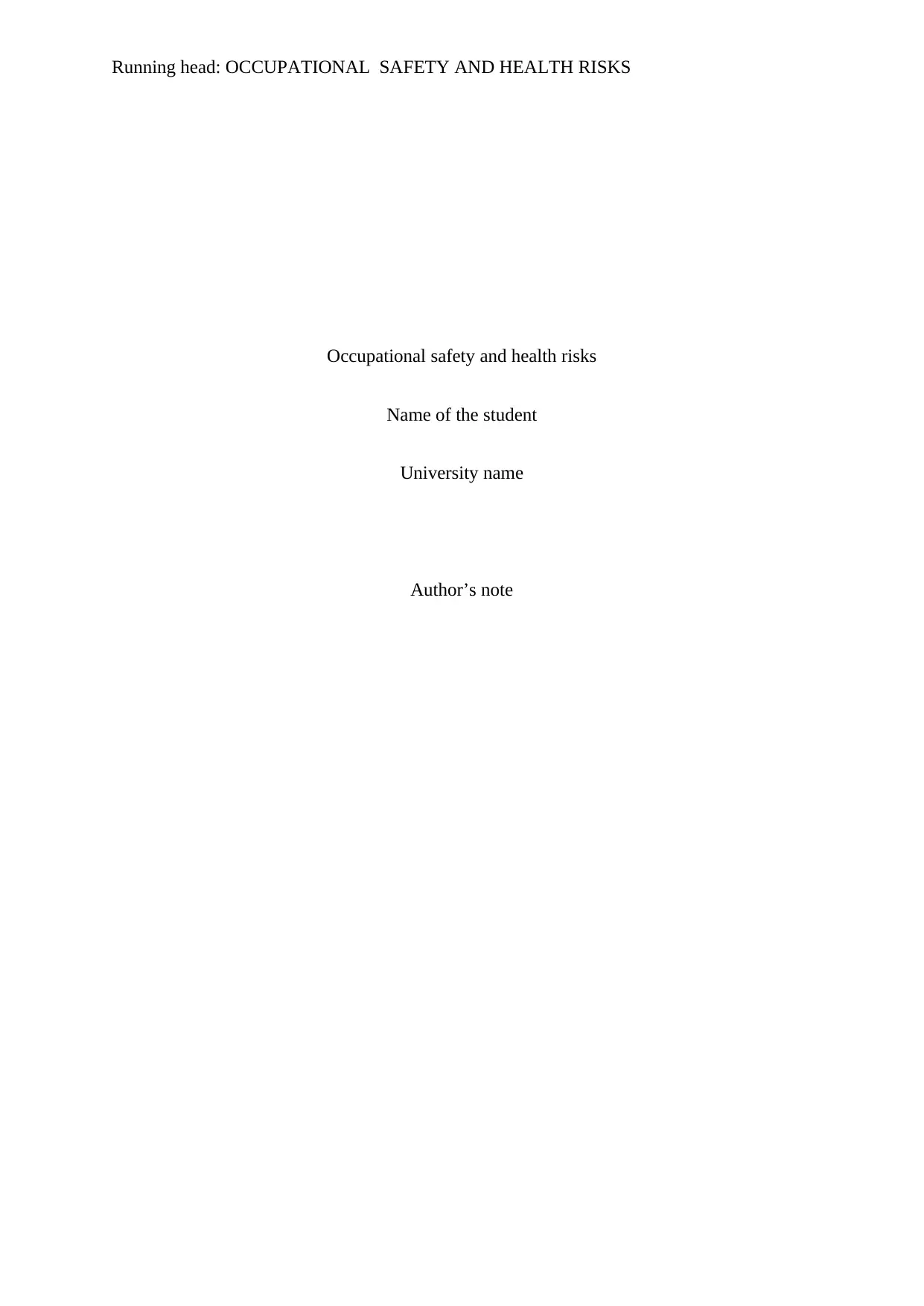
Running head: OCCUPATIONAL SAFETY AND HEALTH RISKS
Occupational safety and health risks
Name of the student
University name
Author’s note
Occupational safety and health risks
Name of the student
University name
Author’s note
Paraphrase This Document
Need a fresh take? Get an instant paraphrase of this document with our AI Paraphraser
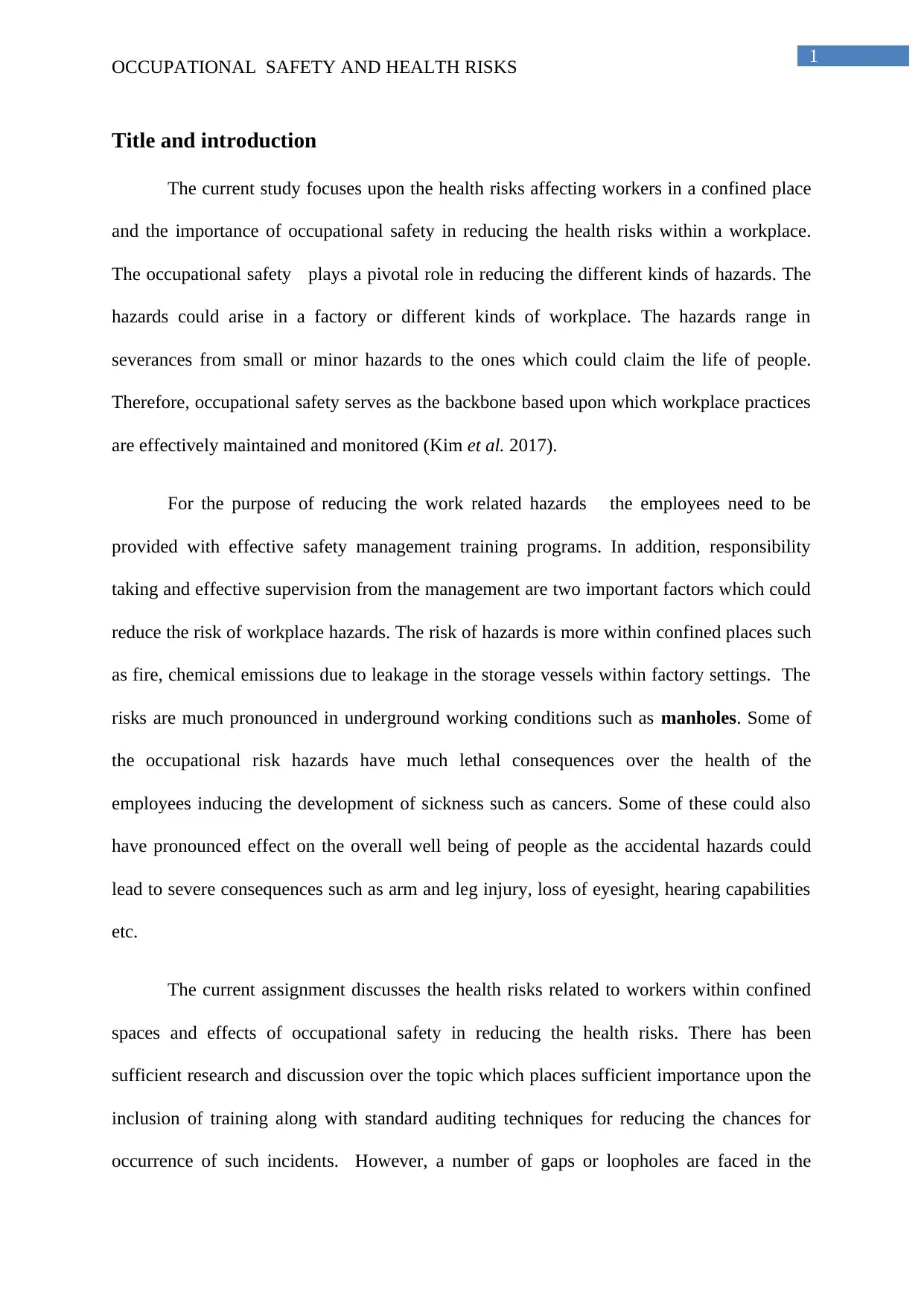
1
OCCUPATIONAL SAFETY AND HEALTH RISKS
Title and introduction
The current study focuses upon the health risks affecting workers in a confined place
and the importance of occupational safety in reducing the health risks within a workplace.
The occupational safety plays a pivotal role in reducing the different kinds of hazards. The
hazards could arise in a factory or different kinds of workplace. The hazards range in
severances from small or minor hazards to the ones which could claim the life of people.
Therefore, occupational safety serves as the backbone based upon which workplace practices
are effectively maintained and monitored (Kim et al. 2017).
For the purpose of reducing the work related hazards the employees need to be
provided with effective safety management training programs. In addition, responsibility
taking and effective supervision from the management are two important factors which could
reduce the risk of workplace hazards. The risk of hazards is more within confined places such
as fire, chemical emissions due to leakage in the storage vessels within factory settings. The
risks are much pronounced in underground working conditions such as manholes. Some of
the occupational risk hazards have much lethal consequences over the health of the
employees inducing the development of sickness such as cancers. Some of these could also
have pronounced effect on the overall well being of people as the accidental hazards could
lead to severe consequences such as arm and leg injury, loss of eyesight, hearing capabilities
etc.
The current assignment discusses the health risks related to workers within confined
spaces and effects of occupational safety in reducing the health risks. There has been
sufficient research and discussion over the topic which places sufficient importance upon the
inclusion of training along with standard auditing techniques for reducing the chances for
occurrence of such incidents. However, a number of gaps or loopholes are faced in the
OCCUPATIONAL SAFETY AND HEALTH RISKS
Title and introduction
The current study focuses upon the health risks affecting workers in a confined place
and the importance of occupational safety in reducing the health risks within a workplace.
The occupational safety plays a pivotal role in reducing the different kinds of hazards. The
hazards could arise in a factory or different kinds of workplace. The hazards range in
severances from small or minor hazards to the ones which could claim the life of people.
Therefore, occupational safety serves as the backbone based upon which workplace practices
are effectively maintained and monitored (Kim et al. 2017).
For the purpose of reducing the work related hazards the employees need to be
provided with effective safety management training programs. In addition, responsibility
taking and effective supervision from the management are two important factors which could
reduce the risk of workplace hazards. The risk of hazards is more within confined places such
as fire, chemical emissions due to leakage in the storage vessels within factory settings. The
risks are much pronounced in underground working conditions such as manholes. Some of
the occupational risk hazards have much lethal consequences over the health of the
employees inducing the development of sickness such as cancers. Some of these could also
have pronounced effect on the overall well being of people as the accidental hazards could
lead to severe consequences such as arm and leg injury, loss of eyesight, hearing capabilities
etc.
The current assignment discusses the health risks related to workers within confined
spaces and effects of occupational safety in reducing the health risks. There has been
sufficient research and discussion over the topic which places sufficient importance upon the
inclusion of training along with standard auditing techniques for reducing the chances for
occurrence of such incidents. However, a number of gaps or loopholes are faced in the
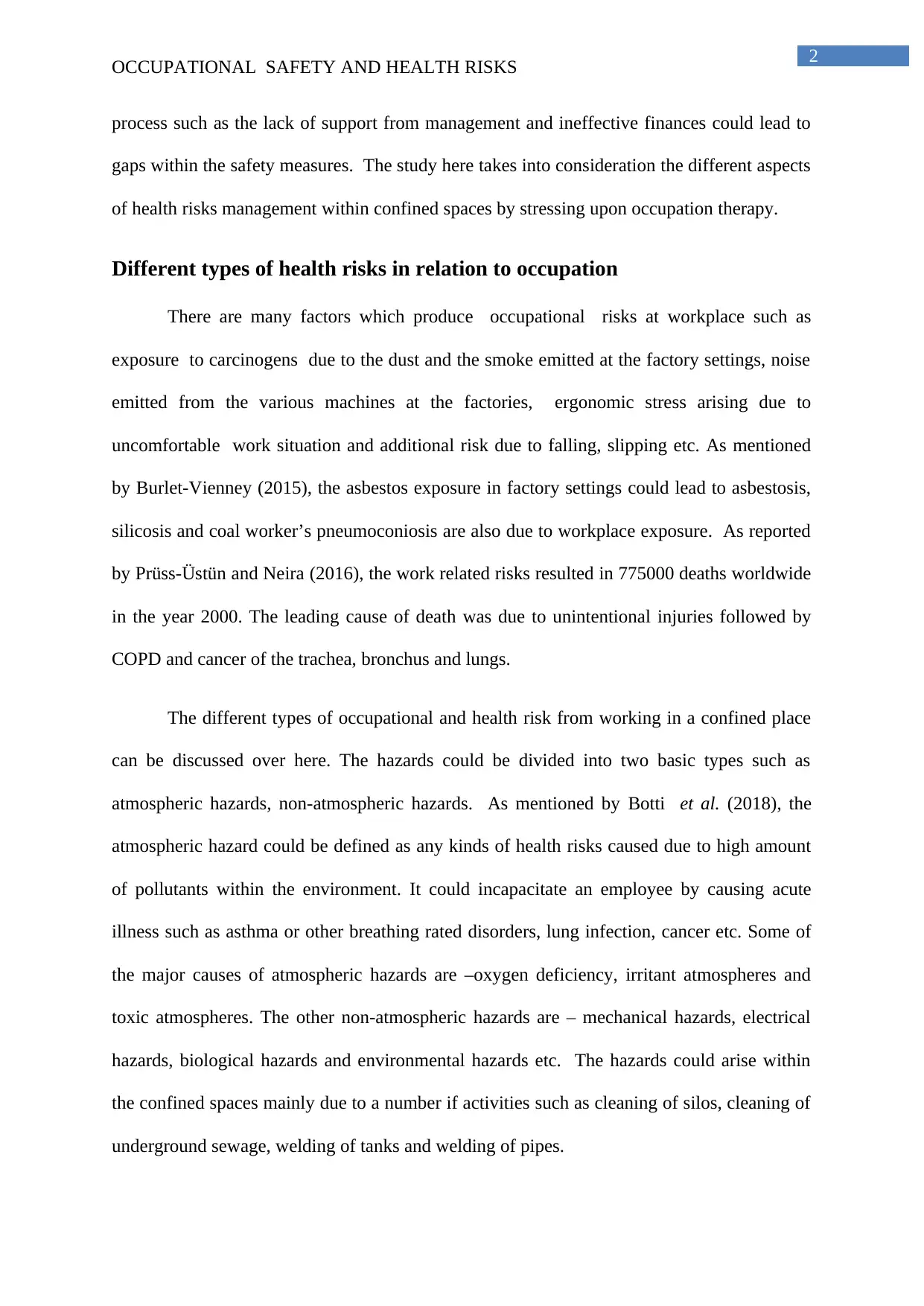
2
OCCUPATIONAL SAFETY AND HEALTH RISKS
process such as the lack of support from management and ineffective finances could lead to
gaps within the safety measures. The study here takes into consideration the different aspects
of health risks management within confined spaces by stressing upon occupation therapy.
Different types of health risks in relation to occupation
There are many factors which produce occupational risks at workplace such as
exposure to carcinogens due to the dust and the smoke emitted at the factory settings, noise
emitted from the various machines at the factories, ergonomic stress arising due to
uncomfortable work situation and additional risk due to falling, slipping etc. As mentioned
by Burlet-Vienney (2015), the asbestos exposure in factory settings could lead to asbestosis,
silicosis and coal worker’s pneumoconiosis are also due to workplace exposure. As reported
by Prüss-Üstün and Neira (2016), the work related risks resulted in 775000 deaths worldwide
in the year 2000. The leading cause of death was due to unintentional injuries followed by
COPD and cancer of the trachea, bronchus and lungs.
The different types of occupational and health risk from working in a confined place
can be discussed over here. The hazards could be divided into two basic types such as
atmospheric hazards, non-atmospheric hazards. As mentioned by Botti et al. (2018), the
atmospheric hazard could be defined as any kinds of health risks caused due to high amount
of pollutants within the environment. It could incapacitate an employee by causing acute
illness such as asthma or other breathing rated disorders, lung infection, cancer etc. Some of
the major causes of atmospheric hazards are –oxygen deficiency, irritant atmospheres and
toxic atmospheres. The other non-atmospheric hazards are – mechanical hazards, electrical
hazards, biological hazards and environmental hazards etc. The hazards could arise within
the confined spaces mainly due to a number if activities such as cleaning of silos, cleaning of
underground sewage, welding of tanks and welding of pipes.
OCCUPATIONAL SAFETY AND HEALTH RISKS
process such as the lack of support from management and ineffective finances could lead to
gaps within the safety measures. The study here takes into consideration the different aspects
of health risks management within confined spaces by stressing upon occupation therapy.
Different types of health risks in relation to occupation
There are many factors which produce occupational risks at workplace such as
exposure to carcinogens due to the dust and the smoke emitted at the factory settings, noise
emitted from the various machines at the factories, ergonomic stress arising due to
uncomfortable work situation and additional risk due to falling, slipping etc. As mentioned
by Burlet-Vienney (2015), the asbestos exposure in factory settings could lead to asbestosis,
silicosis and coal worker’s pneumoconiosis are also due to workplace exposure. As reported
by Prüss-Üstün and Neira (2016), the work related risks resulted in 775000 deaths worldwide
in the year 2000. The leading cause of death was due to unintentional injuries followed by
COPD and cancer of the trachea, bronchus and lungs.
The different types of occupational and health risk from working in a confined place
can be discussed over here. The hazards could be divided into two basic types such as
atmospheric hazards, non-atmospheric hazards. As mentioned by Botti et al. (2018), the
atmospheric hazard could be defined as any kinds of health risks caused due to high amount
of pollutants within the environment. It could incapacitate an employee by causing acute
illness such as asthma or other breathing rated disorders, lung infection, cancer etc. Some of
the major causes of atmospheric hazards are –oxygen deficiency, irritant atmospheres and
toxic atmospheres. The other non-atmospheric hazards are – mechanical hazards, electrical
hazards, biological hazards and environmental hazards etc. The hazards could arise within
the confined spaces mainly due to a number if activities such as cleaning of silos, cleaning of
underground sewage, welding of tanks and welding of pipes.
⊘ This is a preview!⊘
Do you want full access?
Subscribe today to unlock all pages.

Trusted by 1+ million students worldwide
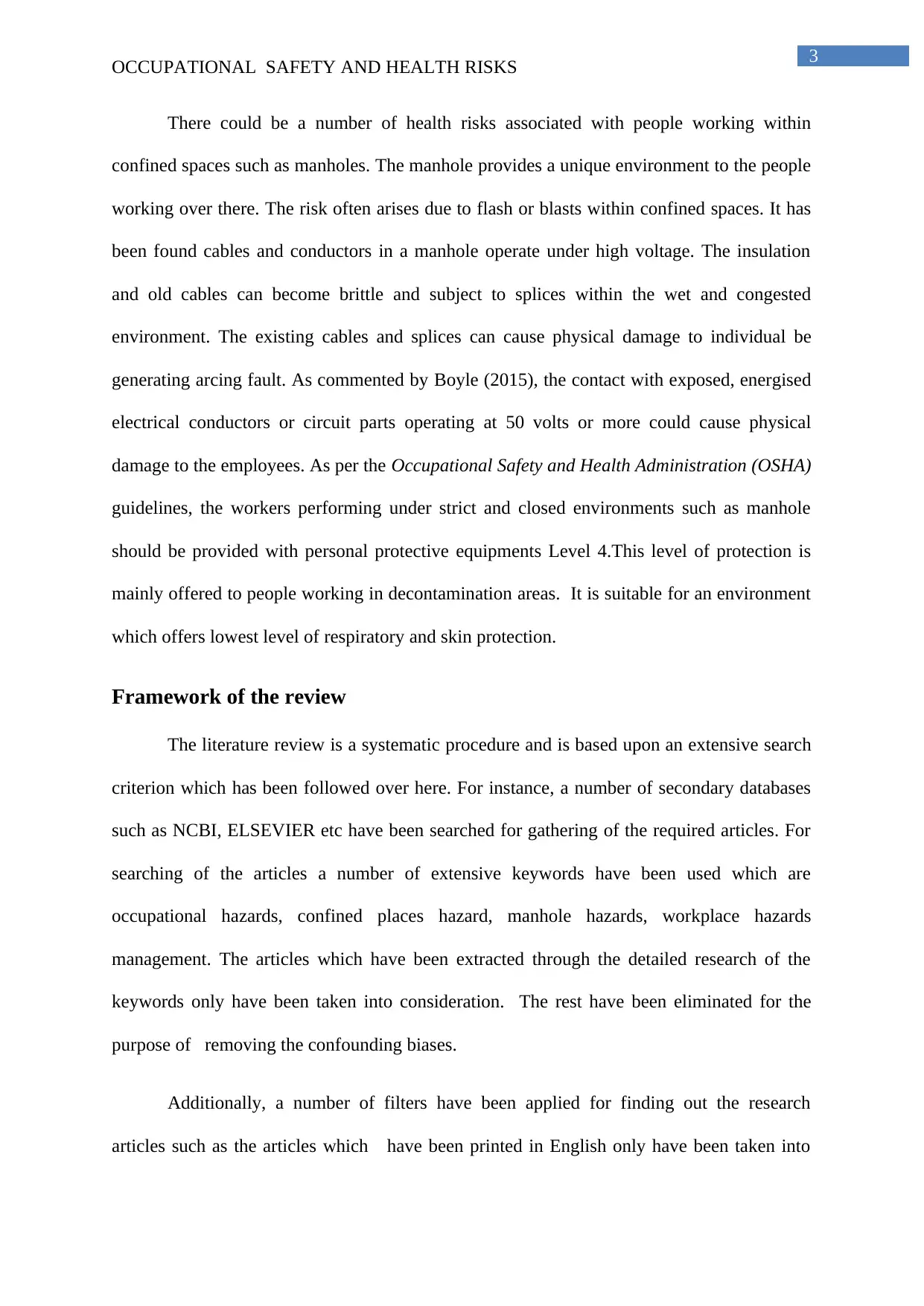
3
OCCUPATIONAL SAFETY AND HEALTH RISKS
There could be a number of health risks associated with people working within
confined spaces such as manholes. The manhole provides a unique environment to the people
working over there. The risk often arises due to flash or blasts within confined spaces. It has
been found cables and conductors in a manhole operate under high voltage. The insulation
and old cables can become brittle and subject to splices within the wet and congested
environment. The existing cables and splices can cause physical damage to individual be
generating arcing fault. As commented by Boyle (2015), the contact with exposed, energised
electrical conductors or circuit parts operating at 50 volts or more could cause physical
damage to the employees. As per the Occupational Safety and Health Administration (OSHA)
guidelines, the workers performing under strict and closed environments such as manhole
should be provided with personal protective equipments Level 4.This level of protection is
mainly offered to people working in decontamination areas. It is suitable for an environment
which offers lowest level of respiratory and skin protection.
Framework of the review
The literature review is a systematic procedure and is based upon an extensive search
criterion which has been followed over here. For instance, a number of secondary databases
such as NCBI, ELSEVIER etc have been searched for gathering of the required articles. For
searching of the articles a number of extensive keywords have been used which are
occupational hazards, confined places hazard, manhole hazards, workplace hazards
management. The articles which have been extracted through the detailed research of the
keywords only have been taken into consideration. The rest have been eliminated for the
purpose of removing the confounding biases.
Additionally, a number of filters have been applied for finding out the research
articles such as the articles which have been printed in English only have been taken into
OCCUPATIONAL SAFETY AND HEALTH RISKS
There could be a number of health risks associated with people working within
confined spaces such as manholes. The manhole provides a unique environment to the people
working over there. The risk often arises due to flash or blasts within confined spaces. It has
been found cables and conductors in a manhole operate under high voltage. The insulation
and old cables can become brittle and subject to splices within the wet and congested
environment. The existing cables and splices can cause physical damage to individual be
generating arcing fault. As commented by Boyle (2015), the contact with exposed, energised
electrical conductors or circuit parts operating at 50 volts or more could cause physical
damage to the employees. As per the Occupational Safety and Health Administration (OSHA)
guidelines, the workers performing under strict and closed environments such as manhole
should be provided with personal protective equipments Level 4.This level of protection is
mainly offered to people working in decontamination areas. It is suitable for an environment
which offers lowest level of respiratory and skin protection.
Framework of the review
The literature review is a systematic procedure and is based upon an extensive search
criterion which has been followed over here. For instance, a number of secondary databases
such as NCBI, ELSEVIER etc have been searched for gathering of the required articles. For
searching of the articles a number of extensive keywords have been used which are
occupational hazards, confined places hazard, manhole hazards, workplace hazards
management. The articles which have been extracted through the detailed research of the
keywords only have been taken into consideration. The rest have been eliminated for the
purpose of removing the confounding biases.
Additionally, a number of filters have been applied for finding out the research
articles such as the articles which have been printed in English only have been taken into
Paraphrase This Document
Need a fresh take? Get an instant paraphrase of this document with our AI Paraphraser
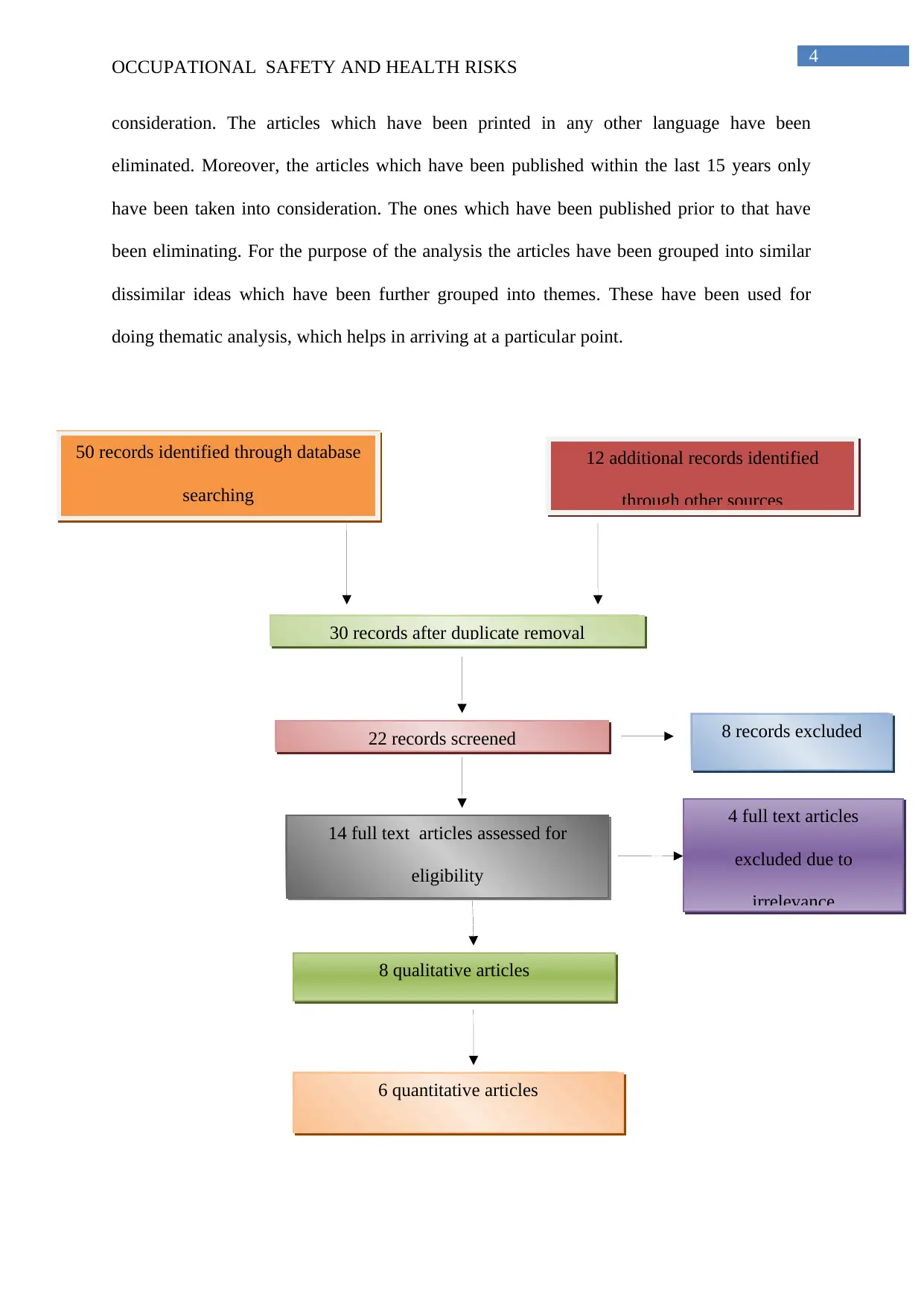
4
OCCUPATIONAL SAFETY AND HEALTH RISKS
consideration. The articles which have been printed in any other language have been
eliminated. Moreover, the articles which have been published within the last 15 years only
have been taken into consideration. The ones which have been published prior to that have
been eliminating. For the purpose of the analysis the articles have been grouped into similar
dissimilar ideas which have been further grouped into themes. These have been used for
doing thematic analysis, which helps in arriving at a particular point.
50 records identified through database
searching
30 records after duplicate removal
22 records screened
14 full text articles assessed for
eligibility
8 qualitative articles
6 quantitative articles
12 additional records identified
through other sources
8 records excluded
4 full text articles
excluded due to
irrelevance
OCCUPATIONAL SAFETY AND HEALTH RISKS
consideration. The articles which have been printed in any other language have been
eliminated. Moreover, the articles which have been published within the last 15 years only
have been taken into consideration. The ones which have been published prior to that have
been eliminating. For the purpose of the analysis the articles have been grouped into similar
dissimilar ideas which have been further grouped into themes. These have been used for
doing thematic analysis, which helps in arriving at a particular point.
50 records identified through database
searching
30 records after duplicate removal
22 records screened
14 full text articles assessed for
eligibility
8 qualitative articles
6 quantitative articles
12 additional records identified
through other sources
8 records excluded
4 full text articles
excluded due to
irrelevance
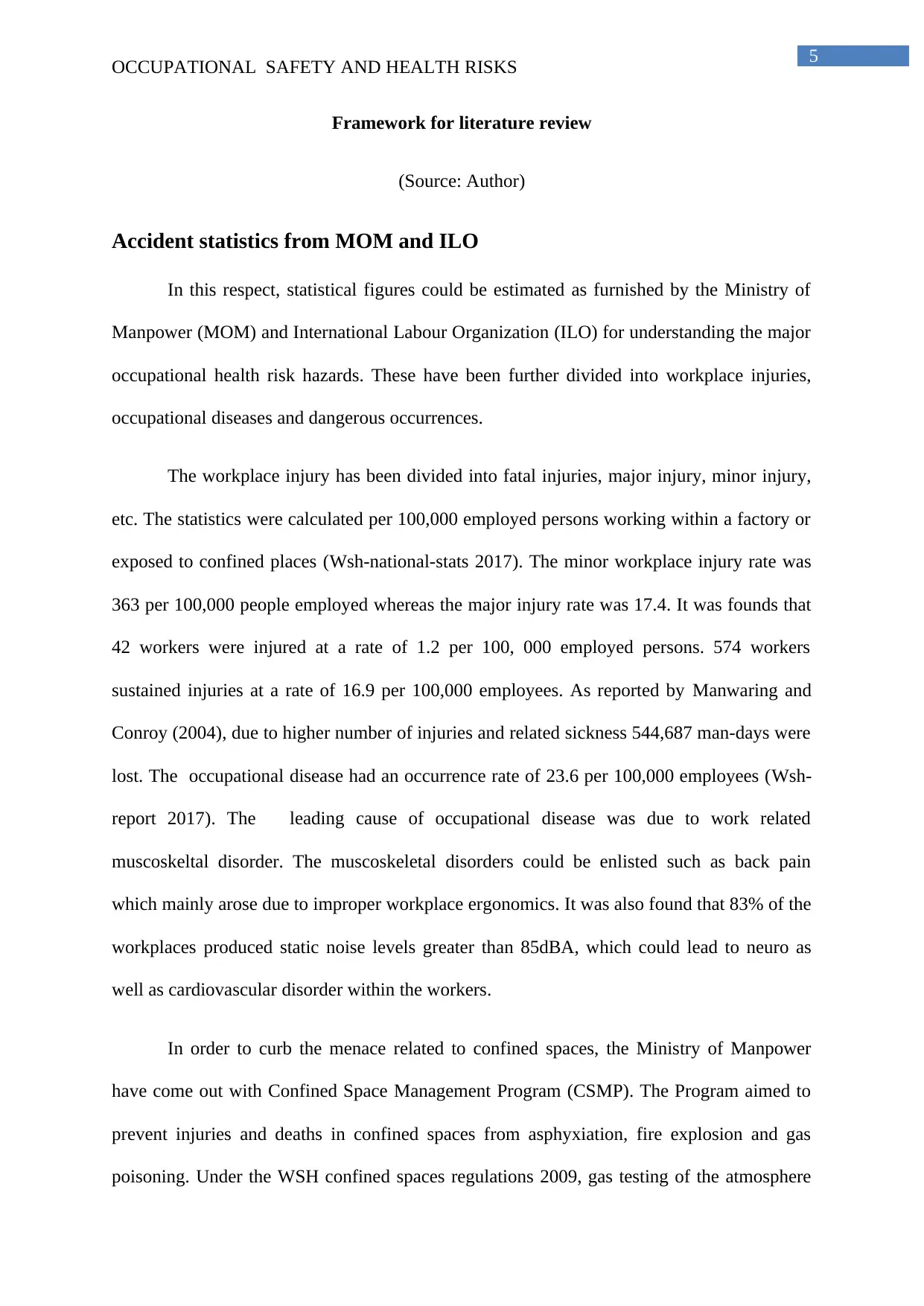
5
OCCUPATIONAL SAFETY AND HEALTH RISKS
Framework for literature review
(Source: Author)
Accident statistics from MOM and ILO
In this respect, statistical figures could be estimated as furnished by the Ministry of
Manpower (MOM) and International Labour Organization (ILO) for understanding the major
occupational health risk hazards. These have been further divided into workplace injuries,
occupational diseases and dangerous occurrences.
The workplace injury has been divided into fatal injuries, major injury, minor injury,
etc. The statistics were calculated per 100,000 employed persons working within a factory or
exposed to confined places (Wsh-national-stats 2017). The minor workplace injury rate was
363 per 100,000 people employed whereas the major injury rate was 17.4. It was founds that
42 workers were injured at a rate of 1.2 per 100, 000 employed persons. 574 workers
sustained injuries at a rate of 16.9 per 100,000 employees. As reported by Manwaring and
Conroy (2004), due to higher number of injuries and related sickness 544,687 man-days were
lost. The occupational disease had an occurrence rate of 23.6 per 100,000 employees (Wsh-
report 2017). The leading cause of occupational disease was due to work related
muscoskeltal disorder. The muscoskeletal disorders could be enlisted such as back pain
which mainly arose due to improper workplace ergonomics. It was also found that 83% of the
workplaces produced static noise levels greater than 85dBA, which could lead to neuro as
well as cardiovascular disorder within the workers.
In order to curb the menace related to confined spaces, the Ministry of Manpower
have come out with Confined Space Management Program (CSMP). The Program aimed to
prevent injuries and deaths in confined spaces from asphyxiation, fire explosion and gas
poisoning. Under the WSH confined spaces regulations 2009, gas testing of the atmosphere
OCCUPATIONAL SAFETY AND HEALTH RISKS
Framework for literature review
(Source: Author)
Accident statistics from MOM and ILO
In this respect, statistical figures could be estimated as furnished by the Ministry of
Manpower (MOM) and International Labour Organization (ILO) for understanding the major
occupational health risk hazards. These have been further divided into workplace injuries,
occupational diseases and dangerous occurrences.
The workplace injury has been divided into fatal injuries, major injury, minor injury,
etc. The statistics were calculated per 100,000 employed persons working within a factory or
exposed to confined places (Wsh-national-stats 2017). The minor workplace injury rate was
363 per 100,000 people employed whereas the major injury rate was 17.4. It was founds that
42 workers were injured at a rate of 1.2 per 100, 000 employed persons. 574 workers
sustained injuries at a rate of 16.9 per 100,000 employees. As reported by Manwaring and
Conroy (2004), due to higher number of injuries and related sickness 544,687 man-days were
lost. The occupational disease had an occurrence rate of 23.6 per 100,000 employees (Wsh-
report 2017). The leading cause of occupational disease was due to work related
muscoskeltal disorder. The muscoskeletal disorders could be enlisted such as back pain
which mainly arose due to improper workplace ergonomics. It was also found that 83% of the
workplaces produced static noise levels greater than 85dBA, which could lead to neuro as
well as cardiovascular disorder within the workers.
In order to curb the menace related to confined spaces, the Ministry of Manpower
have come out with Confined Space Management Program (CSMP). The Program aimed to
prevent injuries and deaths in confined spaces from asphyxiation, fire explosion and gas
poisoning. Under the WSH confined spaces regulations 2009, gas testing of the atmosphere
⊘ This is a preview!⊘
Do you want full access?
Subscribe today to unlock all pages.

Trusted by 1+ million students worldwide
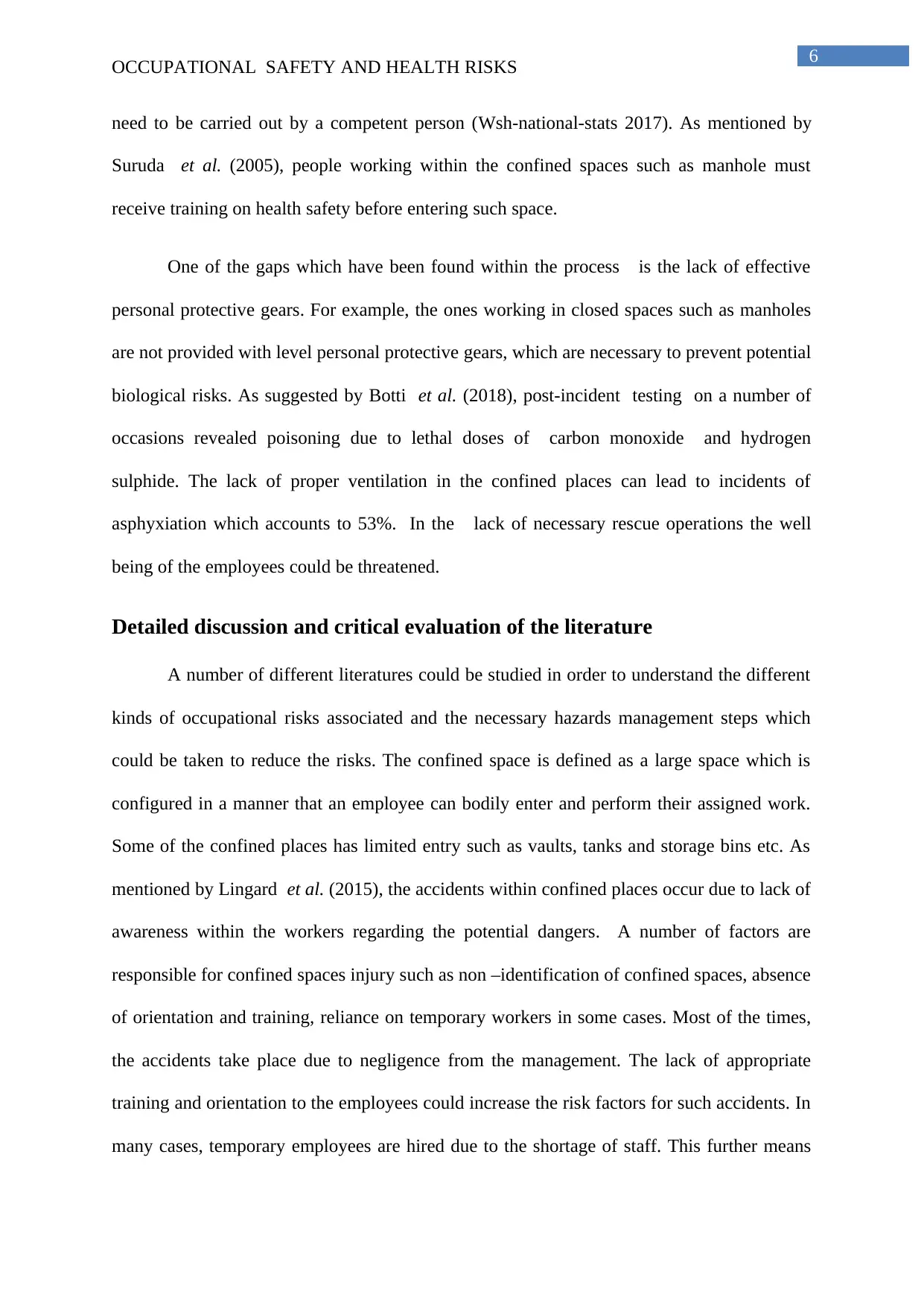
6
OCCUPATIONAL SAFETY AND HEALTH RISKS
need to be carried out by a competent person (Wsh-national-stats 2017). As mentioned by
Suruda et al. (2005), people working within the confined spaces such as manhole must
receive training on health safety before entering such space.
One of the gaps which have been found within the process is the lack of effective
personal protective gears. For example, the ones working in closed spaces such as manholes
are not provided with level personal protective gears, which are necessary to prevent potential
biological risks. As suggested by Botti et al. (2018), post-incident testing on a number of
occasions revealed poisoning due to lethal doses of carbon monoxide and hydrogen
sulphide. The lack of proper ventilation in the confined places can lead to incidents of
asphyxiation which accounts to 53%. In the lack of necessary rescue operations the well
being of the employees could be threatened.
Detailed discussion and critical evaluation of the literature
A number of different literatures could be studied in order to understand the different
kinds of occupational risks associated and the necessary hazards management steps which
could be taken to reduce the risks. The confined space is defined as a large space which is
configured in a manner that an employee can bodily enter and perform their assigned work.
Some of the confined places has limited entry such as vaults, tanks and storage bins etc. As
mentioned by Lingard et al. (2015), the accidents within confined places occur due to lack of
awareness within the workers regarding the potential dangers. A number of factors are
responsible for confined spaces injury such as non –identification of confined spaces, absence
of orientation and training, reliance on temporary workers in some cases. Most of the times,
the accidents take place due to negligence from the management. The lack of appropriate
training and orientation to the employees could increase the risk factors for such accidents. In
many cases, temporary employees are hired due to the shortage of staff. This further means
OCCUPATIONAL SAFETY AND HEALTH RISKS
need to be carried out by a competent person (Wsh-national-stats 2017). As mentioned by
Suruda et al. (2005), people working within the confined spaces such as manhole must
receive training on health safety before entering such space.
One of the gaps which have been found within the process is the lack of effective
personal protective gears. For example, the ones working in closed spaces such as manholes
are not provided with level personal protective gears, which are necessary to prevent potential
biological risks. As suggested by Botti et al. (2018), post-incident testing on a number of
occasions revealed poisoning due to lethal doses of carbon monoxide and hydrogen
sulphide. The lack of proper ventilation in the confined places can lead to incidents of
asphyxiation which accounts to 53%. In the lack of necessary rescue operations the well
being of the employees could be threatened.
Detailed discussion and critical evaluation of the literature
A number of different literatures could be studied in order to understand the different
kinds of occupational risks associated and the necessary hazards management steps which
could be taken to reduce the risks. The confined space is defined as a large space which is
configured in a manner that an employee can bodily enter and perform their assigned work.
Some of the confined places has limited entry such as vaults, tanks and storage bins etc. As
mentioned by Lingard et al. (2015), the accidents within confined places occur due to lack of
awareness within the workers regarding the potential dangers. A number of factors are
responsible for confined spaces injury such as non –identification of confined spaces, absence
of orientation and training, reliance on temporary workers in some cases. Most of the times,
the accidents take place due to negligence from the management. The lack of appropriate
training and orientation to the employees could increase the risk factors for such accidents. In
many cases, temporary employees are hired due to the shortage of staff. This further means
Paraphrase This Document
Need a fresh take? Get an instant paraphrase of this document with our AI Paraphraser

7
OCCUPATIONAL SAFETY AND HEALTH RISKS
that many of the temporary employees hired lacked the specific expertise to manage the
tasks. Some of the additional barriers which are faced over here are the unawareness in the
employers regarding the importance of conducting training. Additionally, lack of funding can
also affect the implementation of the training measures (Botti et al. 2018). The lack of a
positive work culture can further affect the proper implementation of safety measures.
The lack of a positive work culture can result in disputes within the management and
employee. An irresponsible management can lead to safety gaps which could in turn put the
life of the employees at risk. The lack of funding, staff absenteeism are some of the additional
factors. There are large number of public and private sector industries , a few of which are
not properly registered and fail to follow the legal guidelines based on safety measures. As
argued by Hamid et al. (2017), the companies which are not properly registered fail to
receive sufficient funds from the government which affects their safety infrastructure.
Another factor which is worth concern over here is high amount of absenteeism or lack of
trained staff. The gap is often filled by the employment of the temporary staffs who lack
sufficient skills and knowledge regarding the safety measures. The lack of funds also means
that the employees have to compromise on the protective gears, which are a necessity for
working in confined spaces. The issue of absenteeism have also led to workload imbalance
and leads to the organizations hiring less trained employees or the employees lacking
sufficient expertise with regards to safety management. The high rates of absenteeism could
be due to staff burnout along with less support and poor appraisal from the management. The
labourers often have to spend long working hours in the factory which could lead to burnout.
The lack of funds results in the employers paying less salary bonus to the employees. The
lack of experienced staff further challenges the safety measures of the organization.
OCCUPATIONAL SAFETY AND HEALTH RISKS
that many of the temporary employees hired lacked the specific expertise to manage the
tasks. Some of the additional barriers which are faced over here are the unawareness in the
employers regarding the importance of conducting training. Additionally, lack of funding can
also affect the implementation of the training measures (Botti et al. 2018). The lack of a
positive work culture can further affect the proper implementation of safety measures.
The lack of a positive work culture can result in disputes within the management and
employee. An irresponsible management can lead to safety gaps which could in turn put the
life of the employees at risk. The lack of funding, staff absenteeism are some of the additional
factors. There are large number of public and private sector industries , a few of which are
not properly registered and fail to follow the legal guidelines based on safety measures. As
argued by Hamid et al. (2017), the companies which are not properly registered fail to
receive sufficient funds from the government which affects their safety infrastructure.
Another factor which is worth concern over here is high amount of absenteeism or lack of
trained staff. The gap is often filled by the employment of the temporary staffs who lack
sufficient skills and knowledge regarding the safety measures. The lack of funds also means
that the employees have to compromise on the protective gears, which are a necessity for
working in confined spaces. The issue of absenteeism have also led to workload imbalance
and leads to the organizations hiring less trained employees or the employees lacking
sufficient expertise with regards to safety management. The high rates of absenteeism could
be due to staff burnout along with less support and poor appraisal from the management. The
labourers often have to spend long working hours in the factory which could lead to burnout.
The lack of funds results in the employers paying less salary bonus to the employees. The
lack of experienced staff further challenges the safety measures of the organization.
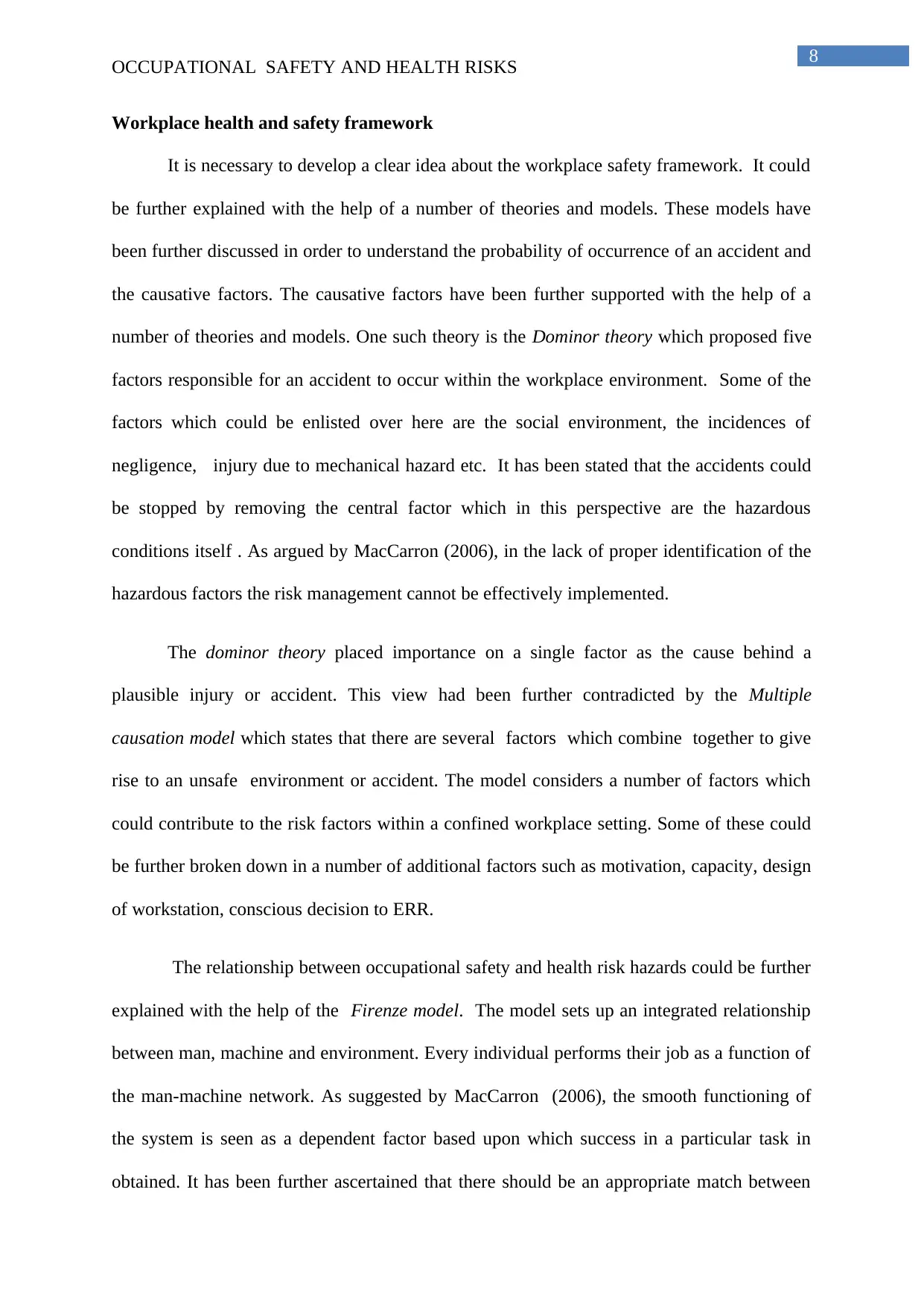
8
OCCUPATIONAL SAFETY AND HEALTH RISKS
Workplace health and safety framework
It is necessary to develop a clear idea about the workplace safety framework. It could
be further explained with the help of a number of theories and models. These models have
been further discussed in order to understand the probability of occurrence of an accident and
the causative factors. The causative factors have been further supported with the help of a
number of theories and models. One such theory is the Dominor theory which proposed five
factors responsible for an accident to occur within the workplace environment. Some of the
factors which could be enlisted over here are the social environment, the incidences of
negligence, injury due to mechanical hazard etc. It has been stated that the accidents could
be stopped by removing the central factor which in this perspective are the hazardous
conditions itself . As argued by MacCarron (2006), in the lack of proper identification of the
hazardous factors the risk management cannot be effectively implemented.
The dominor theory placed importance on a single factor as the cause behind a
plausible injury or accident. This view had been further contradicted by the Multiple
causation model which states that there are several factors which combine together to give
rise to an unsafe environment or accident. The model considers a number of factors which
could contribute to the risk factors within a confined workplace setting. Some of these could
be further broken down in a number of additional factors such as motivation, capacity, design
of workstation, conscious decision to ERR.
The relationship between occupational safety and health risk hazards could be further
explained with the help of the Firenze model. The model sets up an integrated relationship
between man, machine and environment. Every individual performs their job as a function of
the man-machine network. As suggested by MacCarron (2006), the smooth functioning of
the system is seen as a dependent factor based upon which success in a particular task in
obtained. It has been further ascertained that there should be an appropriate match between
OCCUPATIONAL SAFETY AND HEALTH RISKS
Workplace health and safety framework
It is necessary to develop a clear idea about the workplace safety framework. It could
be further explained with the help of a number of theories and models. These models have
been further discussed in order to understand the probability of occurrence of an accident and
the causative factors. The causative factors have been further supported with the help of a
number of theories and models. One such theory is the Dominor theory which proposed five
factors responsible for an accident to occur within the workplace environment. Some of the
factors which could be enlisted over here are the social environment, the incidences of
negligence, injury due to mechanical hazard etc. It has been stated that the accidents could
be stopped by removing the central factor which in this perspective are the hazardous
conditions itself . As argued by MacCarron (2006), in the lack of proper identification of the
hazardous factors the risk management cannot be effectively implemented.
The dominor theory placed importance on a single factor as the cause behind a
plausible injury or accident. This view had been further contradicted by the Multiple
causation model which states that there are several factors which combine together to give
rise to an unsafe environment or accident. The model considers a number of factors which
could contribute to the risk factors within a confined workplace setting. Some of these could
be further broken down in a number of additional factors such as motivation, capacity, design
of workstation, conscious decision to ERR.
The relationship between occupational safety and health risk hazards could be further
explained with the help of the Firenze model. The model sets up an integrated relationship
between man, machine and environment. Every individual performs their job as a function of
the man-machine network. As suggested by MacCarron (2006), the smooth functioning of
the system is seen as a dependent factor based upon which success in a particular task in
obtained. It has been further ascertained that there should be an appropriate match between
⊘ This is a preview!⊘
Do you want full access?
Subscribe today to unlock all pages.

Trusted by 1+ million students worldwide
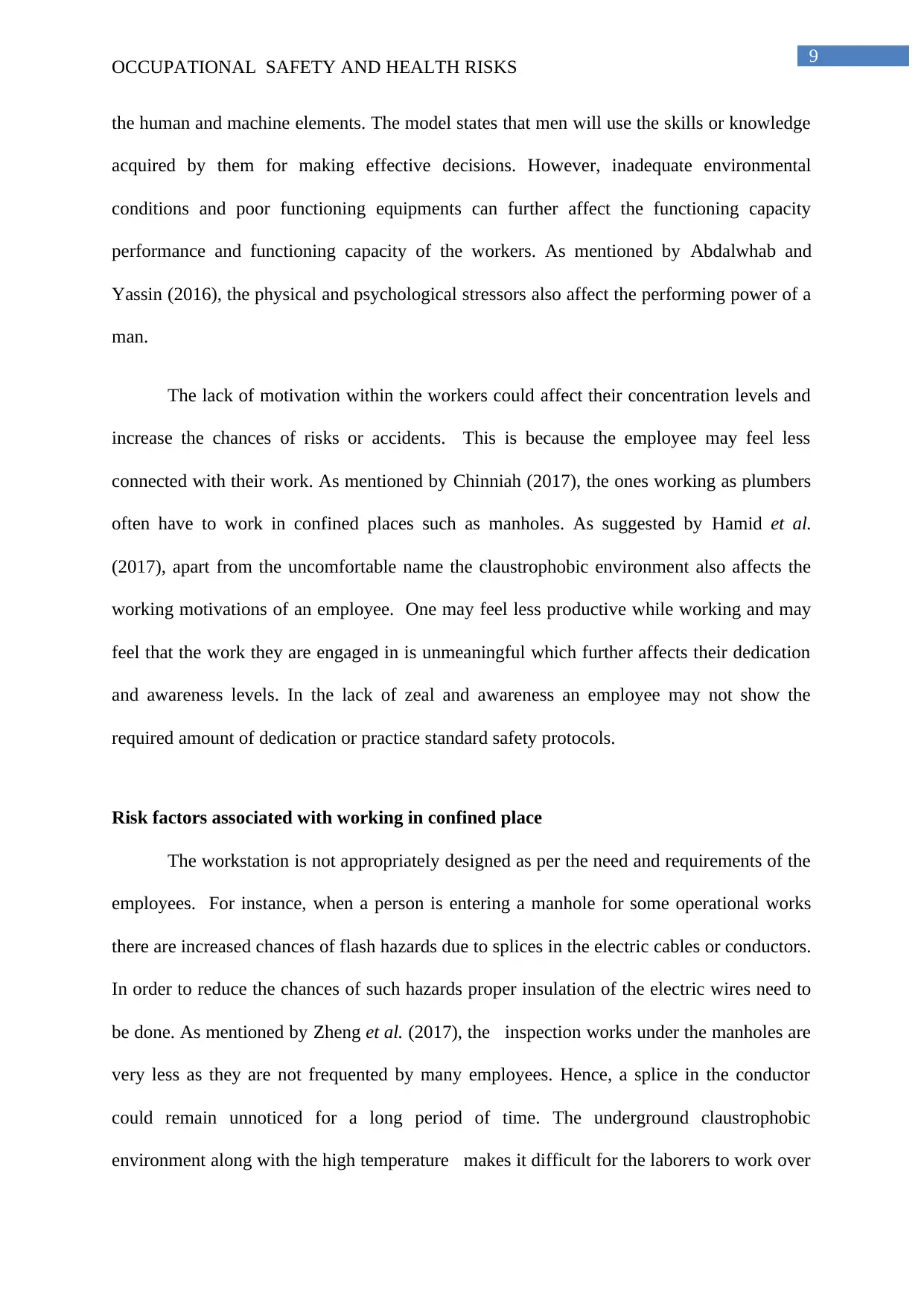
9
OCCUPATIONAL SAFETY AND HEALTH RISKS
the human and machine elements. The model states that men will use the skills or knowledge
acquired by them for making effective decisions. However, inadequate environmental
conditions and poor functioning equipments can further affect the functioning capacity
performance and functioning capacity of the workers. As mentioned by Abdalwhab and
Yassin (2016), the physical and psychological stressors also affect the performing power of a
man.
The lack of motivation within the workers could affect their concentration levels and
increase the chances of risks or accidents. This is because the employee may feel less
connected with their work. As mentioned by Chinniah (2017), the ones working as plumbers
often have to work in confined places such as manholes. As suggested by Hamid et al.
(2017), apart from the uncomfortable name the claustrophobic environment also affects the
working motivations of an employee. One may feel less productive while working and may
feel that the work they are engaged in is unmeaningful which further affects their dedication
and awareness levels. In the lack of zeal and awareness an employee may not show the
required amount of dedication or practice standard safety protocols.
Risk factors associated with working in confined place
The workstation is not appropriately designed as per the need and requirements of the
employees. For instance, when a person is entering a manhole for some operational works
there are increased chances of flash hazards due to splices in the electric cables or conductors.
In order to reduce the chances of such hazards proper insulation of the electric wires need to
be done. As mentioned by Zheng et al. (2017), the inspection works under the manholes are
very less as they are not frequented by many employees. Hence, a splice in the conductor
could remain unnoticed for a long period of time. The underground claustrophobic
environment along with the high temperature makes it difficult for the laborers to work over
OCCUPATIONAL SAFETY AND HEALTH RISKS
the human and machine elements. The model states that men will use the skills or knowledge
acquired by them for making effective decisions. However, inadequate environmental
conditions and poor functioning equipments can further affect the functioning capacity
performance and functioning capacity of the workers. As mentioned by Abdalwhab and
Yassin (2016), the physical and psychological stressors also affect the performing power of a
man.
The lack of motivation within the workers could affect their concentration levels and
increase the chances of risks or accidents. This is because the employee may feel less
connected with their work. As mentioned by Chinniah (2017), the ones working as plumbers
often have to work in confined places such as manholes. As suggested by Hamid et al.
(2017), apart from the uncomfortable name the claustrophobic environment also affects the
working motivations of an employee. One may feel less productive while working and may
feel that the work they are engaged in is unmeaningful which further affects their dedication
and awareness levels. In the lack of zeal and awareness an employee may not show the
required amount of dedication or practice standard safety protocols.
Risk factors associated with working in confined place
The workstation is not appropriately designed as per the need and requirements of the
employees. For instance, when a person is entering a manhole for some operational works
there are increased chances of flash hazards due to splices in the electric cables or conductors.
In order to reduce the chances of such hazards proper insulation of the electric wires need to
be done. As mentioned by Zheng et al. (2017), the inspection works under the manholes are
very less as they are not frequented by many employees. Hence, a splice in the conductor
could remain unnoticed for a long period of time. The underground claustrophobic
environment along with the high temperature makes it difficult for the laborers to work over
Paraphrase This Document
Need a fresh take? Get an instant paraphrase of this document with our AI Paraphraser

10
OCCUPATIONAL SAFETY AND HEALTH RISKS
there. Additionally, below the ground the concentrations of carbon monoxide and hydrogen
peroxide are high which could result in asphyxiation of the laborers working in the
manholes (Cheung et al. 2018). Therefore, focus should be given diverted upon building the
infrastructure further such as the safety vaults which could provide an inlet for fresh oxygen,
as oxygen depletion can make the conditions worse. Additionally, the workers could be
provided with personal protective gears which could reduce the exposure to hazardous
chemicals or vapors.
As mentioned by Blau and Schwartz (2018), lack of sufficient expertise in the
employees could further lead to wrong decision making. For example, a laborer may decide
to use an unguarded machine without knowing the plausible dangers of using the same to the
entire unit. Therefore, the causation of such incidents could be reduced by providing
sufficient training as well as implementing regular audits and internal quality checks by the
employers. As suggested by Boden et al. (2016), ineffective communication gateways could
also affect the safety standards within a workplace setup. It has been seen that incomplete and
poor instructions could lead to the workers being unaware of the associated dangers. Some of
the causes behind such incomplete communication are irresponsible management, absorption
of temporary staffs and sacking of old staffs. As argued by Cooney (2016), the old staffs are
used to the management and can apply individual expertise in understanding the work
assigned. On the other hand, temporary staffs are not well aware of the work conditions and
acquainted with the precautions they have to apply in their field of work. Therefore, putting
the newly appointed staffs under trained leaders could reduce the chances of lethal accidents.
As suggested by Smith et al. (2014), one of the main reasons for maximal amount of staff
turnover is high work pressure, less pay and lack of appreciation from the administration.
The poor communication networks could be mainly attributed to the lack of an effective and
positive work culture. Some of the factors which have been identified over here further
OCCUPATIONAL SAFETY AND HEALTH RISKS
there. Additionally, below the ground the concentrations of carbon monoxide and hydrogen
peroxide are high which could result in asphyxiation of the laborers working in the
manholes (Cheung et al. 2018). Therefore, focus should be given diverted upon building the
infrastructure further such as the safety vaults which could provide an inlet for fresh oxygen,
as oxygen depletion can make the conditions worse. Additionally, the workers could be
provided with personal protective gears which could reduce the exposure to hazardous
chemicals or vapors.
As mentioned by Blau and Schwartz (2018), lack of sufficient expertise in the
employees could further lead to wrong decision making. For example, a laborer may decide
to use an unguarded machine without knowing the plausible dangers of using the same to the
entire unit. Therefore, the causation of such incidents could be reduced by providing
sufficient training as well as implementing regular audits and internal quality checks by the
employers. As suggested by Boden et al. (2016), ineffective communication gateways could
also affect the safety standards within a workplace setup. It has been seen that incomplete and
poor instructions could lead to the workers being unaware of the associated dangers. Some of
the causes behind such incomplete communication are irresponsible management, absorption
of temporary staffs and sacking of old staffs. As argued by Cooney (2016), the old staffs are
used to the management and can apply individual expertise in understanding the work
assigned. On the other hand, temporary staffs are not well aware of the work conditions and
acquainted with the precautions they have to apply in their field of work. Therefore, putting
the newly appointed staffs under trained leaders could reduce the chances of lethal accidents.
As suggested by Smith et al. (2014), one of the main reasons for maximal amount of staff
turnover is high work pressure, less pay and lack of appreciation from the administration.
The poor communication networks could be mainly attributed to the lack of an effective and
positive work culture. Some of the factors which have been identified over here further
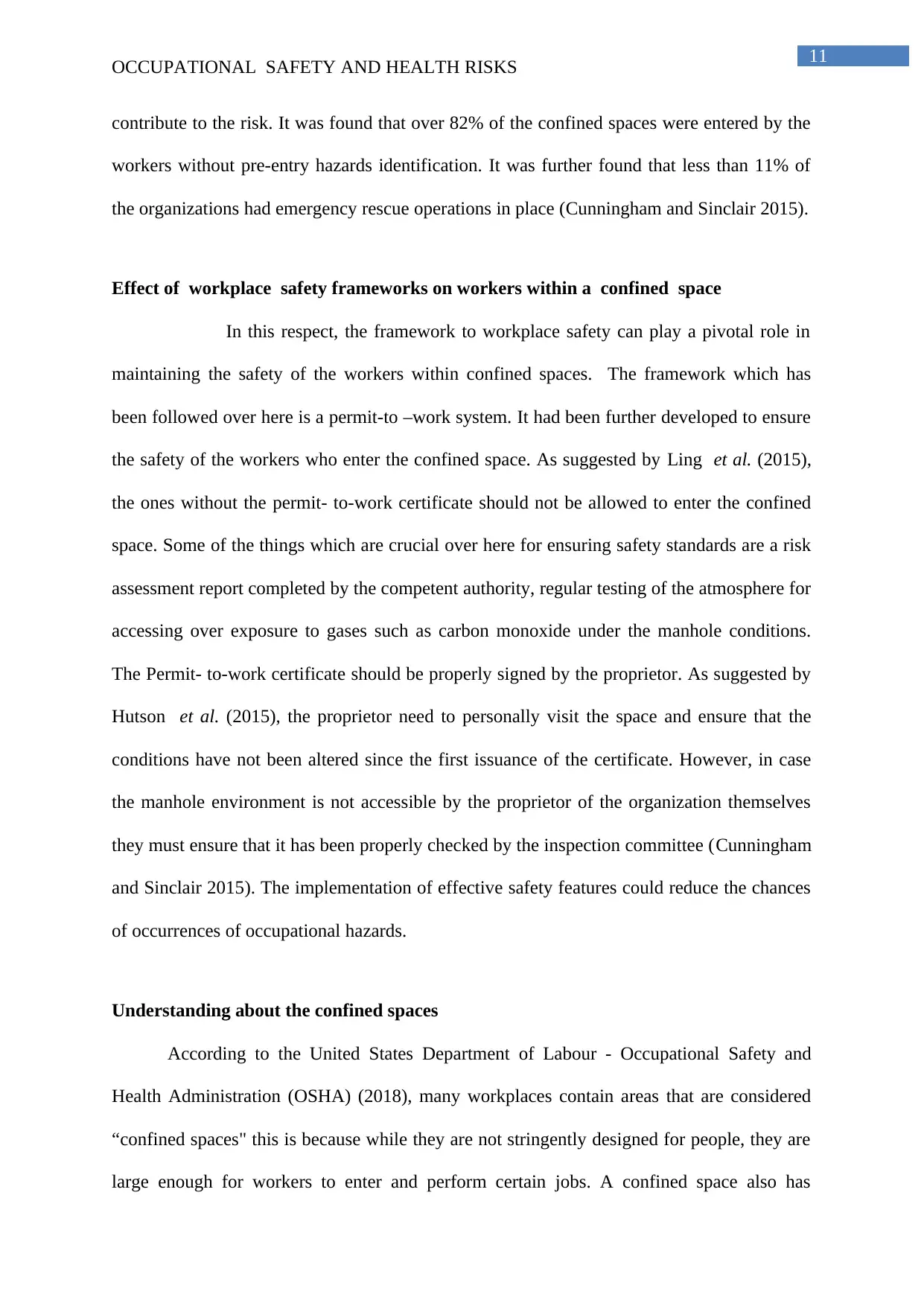
11
OCCUPATIONAL SAFETY AND HEALTH RISKS
contribute to the risk. It was found that over 82% of the confined spaces were entered by the
workers without pre-entry hazards identification. It was further found that less than 11% of
the organizations had emergency rescue operations in place (Cunningham and Sinclair 2015).
Effect of workplace safety frameworks on workers within a confined space
In this respect, the framework to workplace safety can play a pivotal role in
maintaining the safety of the workers within confined spaces. The framework which has
been followed over here is a permit-to –work system. It had been further developed to ensure
the safety of the workers who enter the confined space. As suggested by Ling et al. (2015),
the ones without the permit- to-work certificate should not be allowed to enter the confined
space. Some of the things which are crucial over here for ensuring safety standards are a risk
assessment report completed by the competent authority, regular testing of the atmosphere for
accessing over exposure to gases such as carbon monoxide under the manhole conditions.
The Permit- to-work certificate should be properly signed by the proprietor. As suggested by
Hutson et al. (2015), the proprietor need to personally visit the space and ensure that the
conditions have not been altered since the first issuance of the certificate. However, in case
the manhole environment is not accessible by the proprietor of the organization themselves
they must ensure that it has been properly checked by the inspection committee (Cunningham
and Sinclair 2015). The implementation of effective safety features could reduce the chances
of occurrences of occupational hazards.
Understanding about the confined spaces
According to the United States Department of Labour - Occupational Safety and
Health Administration (OSHA) (2018), many workplaces contain areas that are considered
“confined spaces" this is because while they are not stringently designed for people, they are
large enough for workers to enter and perform certain jobs. A confined space also has
OCCUPATIONAL SAFETY AND HEALTH RISKS
contribute to the risk. It was found that over 82% of the confined spaces were entered by the
workers without pre-entry hazards identification. It was further found that less than 11% of
the organizations had emergency rescue operations in place (Cunningham and Sinclair 2015).
Effect of workplace safety frameworks on workers within a confined space
In this respect, the framework to workplace safety can play a pivotal role in
maintaining the safety of the workers within confined spaces. The framework which has
been followed over here is a permit-to –work system. It had been further developed to ensure
the safety of the workers who enter the confined space. As suggested by Ling et al. (2015),
the ones without the permit- to-work certificate should not be allowed to enter the confined
space. Some of the things which are crucial over here for ensuring safety standards are a risk
assessment report completed by the competent authority, regular testing of the atmosphere for
accessing over exposure to gases such as carbon monoxide under the manhole conditions.
The Permit- to-work certificate should be properly signed by the proprietor. As suggested by
Hutson et al. (2015), the proprietor need to personally visit the space and ensure that the
conditions have not been altered since the first issuance of the certificate. However, in case
the manhole environment is not accessible by the proprietor of the organization themselves
they must ensure that it has been properly checked by the inspection committee (Cunningham
and Sinclair 2015). The implementation of effective safety features could reduce the chances
of occurrences of occupational hazards.
Understanding about the confined spaces
According to the United States Department of Labour - Occupational Safety and
Health Administration (OSHA) (2018), many workplaces contain areas that are considered
“confined spaces" this is because while they are not stringently designed for people, they are
large enough for workers to enter and perform certain jobs. A confined space also has
⊘ This is a preview!⊘
Do you want full access?
Subscribe today to unlock all pages.

Trusted by 1+ million students worldwide
1 out of 27
Related Documents
Your All-in-One AI-Powered Toolkit for Academic Success.
+13062052269
info@desklib.com
Available 24*7 on WhatsApp / Email
![[object Object]](/_next/static/media/star-bottom.7253800d.svg)
Unlock your academic potential
Copyright © 2020–2025 A2Z Services. All Rights Reserved. Developed and managed by ZUCOL.





